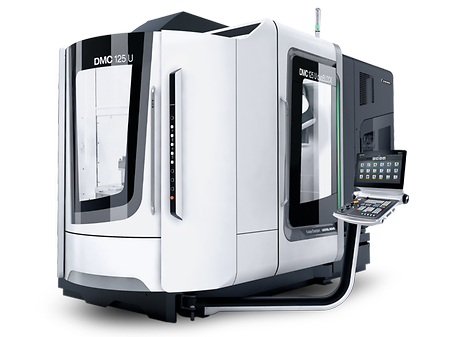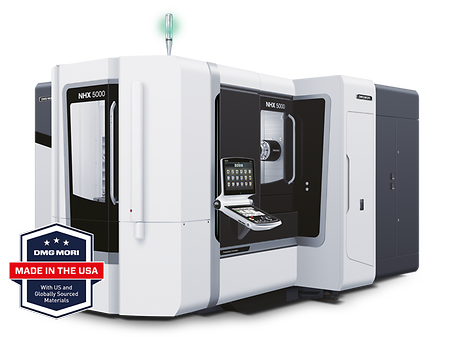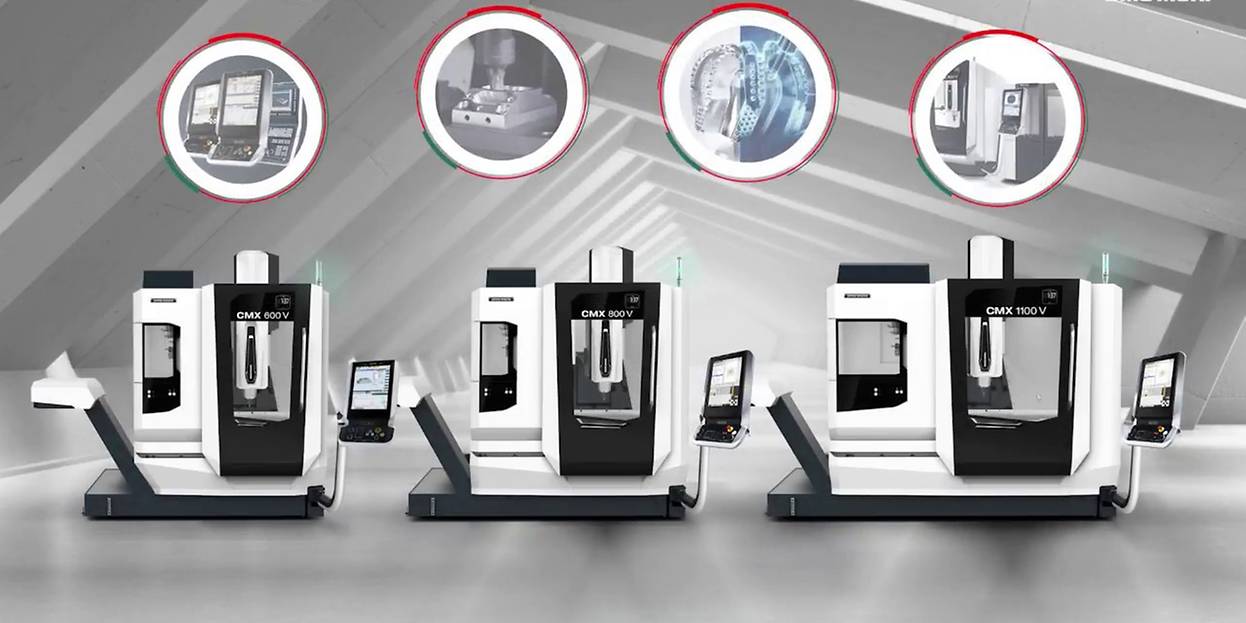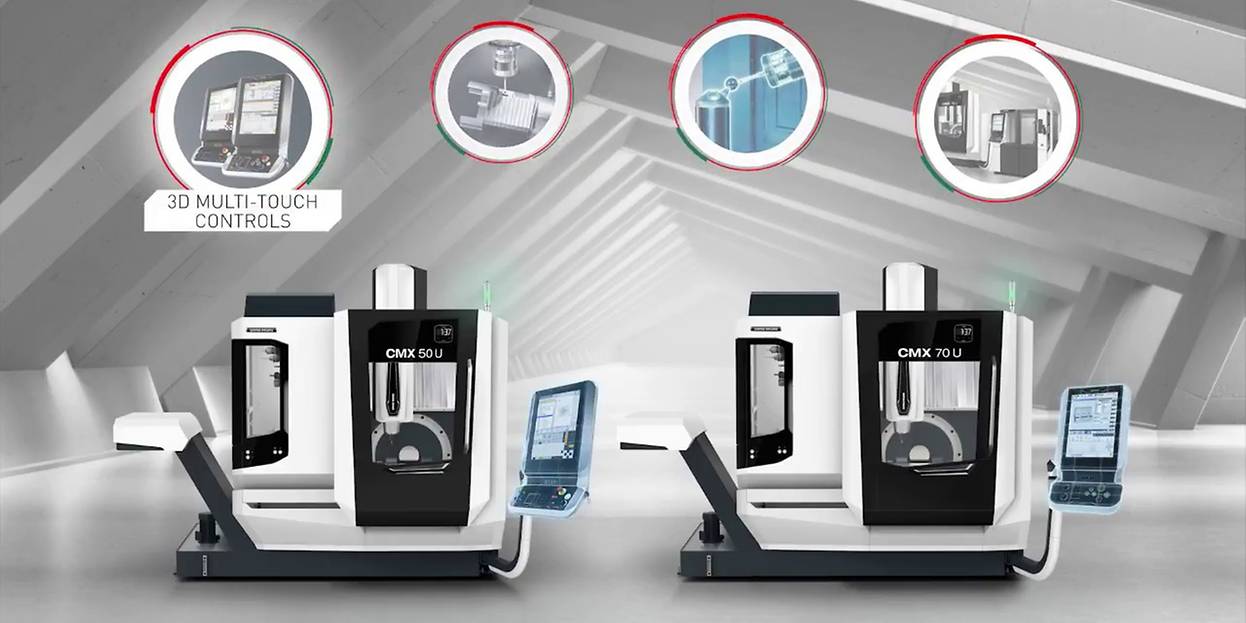Competitive Manufacturing with CNC Milling Machines
DMG MORI has over 100 years of experience with CNC milling machines and comprehensive industry expertise. As a result, the machine tool manufacturer repeatedly sets standards developing versatile and high-performance machining centers. Affordable 3-axis models are just as much a part of the portfolio as universal milling machines for 5-axis simultaneous machining, with which even complex components can be milled efficiently in one clamping.
Top-Seller
From 3-axis milling to 5-axis simultaneous machining
Milling machines are designed for 3-axis machining in their simplest form: The tool moves over the workpiece in the X, Y and Z directions. For example, A rotary axis in the headstock or table expands the machining spectrum because components can also be placed at an angle. However, this is only a preliminary stage for 5-axis milling, which machine tool manufacturers implement via a second rotary axis. This allows almost any orientation of the workpiece, so that it can be machined from five sides in one clamping operation. Components made of metal can also be manufactured in complex geometries. Only the machining of the sixth side requires further clamping.
The supreme discipline of milling has developed out of 5-axis technology: 5-axis simultaneous machining. All axes are interpolated, which gives the milling machine maximum versatility. The kinematics of the CNC machine are usually housed in a swivel rotary table, which continuously moves the component while the milling tool removes material. An alternative is head kinematics. Here, the milling head has two round axes to move freely around a workpiece. The 5-axis simultaneous milling enables the production of so-called free-form surfaces, which are common in mold construction, for example.
Overview
CNC milling machines: the most important things to know, in brief
What is CNC milling?
In CNC milling, a milling tool with geometrically determined cutting edges rotates at high speed about its own axis. By advancing the tool or a workpiece in different axial directions, material is removed and a geometric shape is produced. The movement is computer-controlled during CNC milling, i.e., CNC programs define the milling movements.
Where are CNC milling machines used?
CNC milling is one of the basic manufacturing technologies of the metalworking industry. Milling machines can be used to produce, for example, medical implants, automotive components or components for energy generation. There is also the processing of tools and molds, which in turn are required in other production areas, for example injection molds for the production of plastic components.
What is vertical milling?
During vertical milling, the milling tool is guided from above onto a workpiece to be machined. The vertical construction is a very common design of milling machines, because it offers a clearly visible working area.
What is horizontal milling?
If a workpiece is machined horizontally from the side, this is called horizontal milling. The horizontal position of the spindle creates additional room in the workspace, so that larger components or clamping towers with several workpieces can be accommodated. Having chips fall vertically is also a decisive advantage in precision machining and in applications with a high cutting volume.
What is 5-axis milling?
5-axis milling allows almost any desired movement of the workpiece or the milling head, enabling even complex geometries to be achieved in one clamping. On the one hand, this reduces the throughput times, and, on the other hand, increases the accuracy, because deviations due to re-clamping processes are excluded.
Milling machines for a wide range of applications
Optimal vertical milling machines for any size of workpiece
Reliable milling spindles, powerful motors, innovative cooling systems and tool systems in all common sizes, including fast changers for the milling tools, are what characterize DMG MORI vertical machining centers – paired with the stable construction of the machines. Then there is also the stable construction of the machines. This ensures high long-term repeatability. High-tech controls from SIEMENS, HEIDENHAIN, MITSUBISHI and FANUC ensure precise implementation of demanding tasks at all times simultaneously being convenient to operate.
The variety of the machine product range ensures that users always find a suitable size in vertical milling – from the compact DMP 35 with a minimal footprint to the DMV 185 for components with a length of over 2,000 mm. In addition, the portfolio includes entry-level models such as the M1 or the vertical milling machines of the CMX V series as well as the NVX models for high-precision machining of the most demanding components.
Highlights:
- Sturdy construction and innovative cooling systems for maximum precision
- Future-proof production thanks to modern controls and digitization features
- High-quality components for reliable and productive production
Horizontal milling machines for economical series production
Whether in the precision machining of series components or powerful milling with a high volume, horizontal machining centers from DMG MORI are extremely versatile. Generously sized work areas also offer sufficient space for clamping towers, making it possible to produce large quantities economically in conjunction with a pallet changer and automation solutions.
The series in the horizontal machining center segment of DMG MORI form a complete portfolio for horizontal CNC machining. From the highly stable NHX series for maximum precision to the DMU/DMC H monoBLOCK models for reliable universal machining processes, the high-tech program offers complete tailor-made solutions for every need: from universal milling of changing quantities to highly automated series production of engine components in the automotive industry.
Key Highlights:
- Maximum exploitation of the workspace
- Perfectly suited for series production of precision parts
- Optimal chip fall with high-cutting volume
Productive, complete machining through 5-axis milling
As the world market leader in 5-axis milling, DMG MORI offers entire range of universal milling machines. Consistent, ongoing development of the various models, again and again, yields innovative manufacturing solutions for the highest quality requirements. Volumetric accuracies of up to 15 µm, workpieces weighing up to 120 metric tons or travel distances of up to six meters can be achieved in this segment. In addition, there is process integration with equipment options for milling-turning and grinding.
DMG MORI 5-axis machining centers offer the highest level of flexibility, maximum machining performance, dynamic precision and optimum accessibility. Individual equipment options allow an optimal configuration for the respective applications. The CMX U series in 5-sided machining forms the entry point, while the DMU already enables 50 applications in the premier class, 5-axis simultaneous milling. Meanwhile, the numerous models of the DMU eVo, DMU monoBLOCK and DMU duoBLOCK series meet the different requirements for component size, precision and speed. In addition, the DMU Gantry models and the portal machines complete the portfolio in XXL machining.
Key Highlights:
- Precision, dynamics and productivity with the highest quality standards
- The widest range of machines from 5-axis machining to 5-axis simultaneous milling
- Holistic manufacturing solutions for complete machining including technology integration
More productivity through automated manufacturing solutions and process integration
With a wide range of innovative automation solutions, DMG MORI supports its customers so that they can remain competitive in the global market for the long term. The available products range from standard automation such as PH 150 pallet handling or WH 3 Cell workpiece handling, to Robo2Go Milling as a flexible robot solution, to large round pallet storage systems (RPS) and linear pallet pools (LPP). In addition, driverless transport systems of the AGV series autonomously transport workpieces, pallets or tools from A to B. With its automation expertise, DMG MORI finds a holistic solution for every application.
At DMG MORI, the concept of holistic solutions also includes process integration. In it, the machine tool manufacturer combines different machining processes in one workspace so that complex workpieces can be completely manufactured. In this way, milling machines rotate, interlock and grind components – process steps for which separate machines are used in the traditional way. The result of manufacturing in a single fixture is that the component quality increases significantly and throughput times are drastically reduced.






























































































